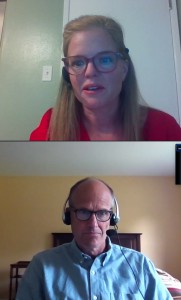[gdlr_button href=”https://energyworkforce.org/wp-content/uploads/2020/09/Oil-and-Gas-Presentation-Parts-1-2_Final.pdf” target=”new” size=”medium” background=”#3d90c7″ color=”#ffffff”]DOWNLOAD THE SLIDES[/gdlr_button]
[gdlr_button href=”https://pesa.quikbox.com/wl/?id=sE6FechiJGoEkqYWxJyQ45bA3tsXQpVk” target=”new” size=”medium” background=”#3d90c7″ color=”#ffffff”]WATCH THE PRESENTATION[/gdlr_button]
On September 15, PESA hosted the National Institute for Occupational Safety and Health (NIOSH) and the Centers for Disease Control and Prevention (CDC) for a webinar on protecting the oil and gas workforce during COVID-19. More than 130 attendees heard from Doug Trout, Chief, Hazard Evaluations and Technical Assistance Branch at NIOSH and Kyla Retzer, Research Epidemiologist at CDC. They addressed screening and testing, as well as specifically what oil and gas employees need to know about COVID-19.
SCREENING
Trout kicked off the presentation with an overview of COVID-19 screening considerations, noting the importance of ensuring sick leave policies are flexible and consistent with public health guidance, and that employees understand these policies prior to implementing screening. Trout emphasized that self-screening and workplace screening needs to be conducted safely and privately. Screening employees for fever and other symptoms is optional and is not a replacement for other protective measures such as social distancing, he said.
TESTING
According to CDC testing guidance, not all people need to be tested. Trout shared the categories/purposes of testing for the disease, which include diagnosis, screening and surveillance. He said it was important to test asymptomatic individuals and those who may have recent known or suspected exposure. Asymptomatic individuals without recent known or suspected exposure may also need to be tested if their workplaces provide congregate housing, are in a remote setting or where social distancing is a challenge.
As companies return to work, Trout emphasized it’s critical to protect yourself and others in the workplace. Understanding the difference between isolation and quarantine, and when each strategy is advisable, is crucial to managing workplace safety during the pandemic.
INDUSTRY WORKERS AND COVID-19
Retzer addressed issues critical to oil and gas companies. She explained steps individuals should take if they’re having COVID-19 symptoms at a work site. Steps include notifying their supervisor immediately, not returning to work until they meet the criteria to discontinue home isolation, communicating with their healthcare provider about when it’s safe to return to work and coordinating with the employer to follow CDC-recommended precautions for when an individual is sick or caring for others who are sick.
Offshore workers should plan movements to reduce risk of exposure to the virus. Steps include being aware when entering areas that may lead to close contact with coworkers and modifying schedules to reduce close contact with other workers.
COVID-19 OIL AND GAS EMPLOYER INFORMATION
Companies can protect staff and slow the spread of the virus by employing a combination of strategies that involve collaboration between workers and management. Retzer recommended creating and implementing a COVID-19 Workplace Health and Safety Plan, taking action if an employee or visitor is suspected or confirmed to have COVID-19 and developing hazard controls using the hierarchy of controls to prevent infection among workers. Companies can support employees by establishing preparedness, response and control plans, collecting information about the workplace and conducting workplace hazard evaluation and prevention activities.
ENGINEERING AND ADMINISTRATIVE CONTROLS
Retzer discussed engineering and administrative controls within the workplace to isolate people from hazards during the pandemic. Implementing controls such as modifying the alignment of workstations where feasible, establishing physical barriers between workers and limiting access to common areas can help reduce the risk of spreading COVID-19. Visual cues are also helpful, such as placing signs throughout a work environment as reminders to maintain social distance of at least six feet. All workplaces should ensure team members understand the importance of limiting the number of people gathered, wearing masks and having access to cleaning stations and disinfectants.
PERSONAL PROTECTIVE EQUIPMENT
Use of Personal Protective Equipment (PPE) during a pandemic is as important as ever but can also be more difficult to use effectively over other measures. Oil and gas workers should continue to use PPE required for their normal jobs and should take care to remember the use of PPE requires characterization of the environment, knowledge of the hazard, training and consistent correct use to be effective, Retzer said.
TRANSPORTATION
Retzer closed with recommended best practices for sharing vehicle spaces during transportation. Limiting the number of people in a vehicle, wearing masks, practicing hand hygiene, disinfecting commonly touched areas and cleaning or disinfecting the vehicle are all ways to prevent the spread of COVID-19 when carpooling.
Additional CDC resources relative to COVID-19 can be found in the presentations. For more information regarding the HSEQ Task Force, contact Senior Director Membership Services Peggy Helfert.





